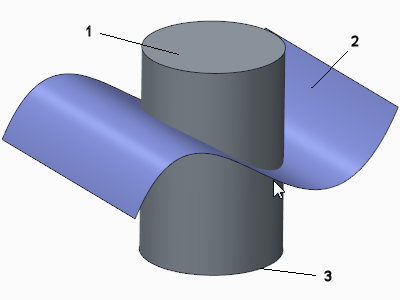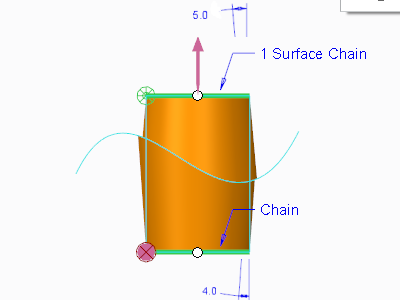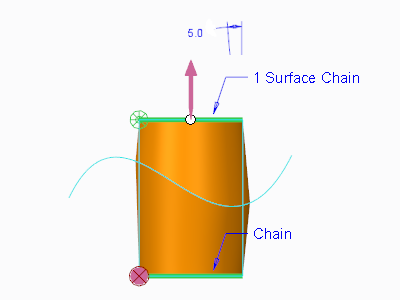Example: Creating a Split Draft with Two Hinges
This example describes creating a split draft with two hinges. The original part is shown in the following illustration.

1. Cylinder
2. Quilt
3. Bottom edges of the cylinder
1. Click > . The Draft tab opens.
2. Select the side surface of the cylinder as the draft surface. The cylinder consists of two halves; the second half is automatically added to the draft surfaces, because by default draft is extended to tangent surfaces.
3. Specify the first hinge. Click the  Draft hinges collector and select the top edge chain of the cylinder. This chain consists of two edges, corresponding to the two halves of the cylindrical surface. To select the edges as a chain, select one edge, hold down the SHIFT key, select the same edge again to indicate that you are adding to this chain, then select the second edge. The Draft hinges collector shows one chain.
Draft hinges collector and select the top edge chain of the cylinder. This chain consists of two edges, corresponding to the two halves of the cylindrical surface. To select the edges as a chain, select one edge, hold down the SHIFT key, select the same edge again to indicate that you are adding to this chain, then select the second edge. The Draft hinges collector shows one chain.
 Draft hinges collector and select the top edge chain of the cylinder. This chain consists of two edges, corresponding to the two halves of the cylindrical surface. To select the edges as a chain, select one edge, hold down the SHIFT key, select the same edge again to indicate that you are adding to this chain, then select the second edge. The Draft hinges collector shows one chain.
Draft hinges collector and select the top edge chain of the cylinder. This chain consists of two edges, corresponding to the two halves of the cylindrical surface. To select the edges as a chain, select one edge, hold down the SHIFT key, select the same edge again to indicate that you are adding to this chain, then select the second edge. The Draft hinges collector shows one chain.4. Click the  Pull direction collector and select the top of the cylinder to define the pull direction.
Pull direction collector and select the top of the cylinder to define the pull direction.
 Pull direction collector and select the top of the cylinder to define the pull direction.
Pull direction collector and select the top of the cylinder to define the pull direction.5. Open the Split tab and select Split by split object from the Split options menu. Select quilt as the split object.
6. Specify the second hinge. Click the  Draft hinges collector to activate it, hold down the CTRL key, and select one of the bottom edges of the cylinder. Release the CTRL key, hold down the SHIFT key, select the same bottom edge again to indicate that you are adding to this chain, and select the second bottom edge, corresponding to the second half of the cylindrical surface. The Draft hinges collector now shows two chains.
Draft hinges collector to activate it, hold down the CTRL key, and select one of the bottom edges of the cylinder. Release the CTRL key, hold down the SHIFT key, select the same bottom edge again to indicate that you are adding to this chain, and select the second bottom edge, corresponding to the second half of the cylindrical surface. The Draft hinges collector now shows two chains.
 Draft hinges collector to activate it, hold down the CTRL key, and select one of the bottom edges of the cylinder. Release the CTRL key, hold down the SHIFT key, select the same bottom edge again to indicate that you are adding to this chain, and select the second bottom edge, corresponding to the second half of the cylindrical surface. The Draft hinges collector now shows two chains.
Draft hinges collector to activate it, hold down the CTRL key, and select one of the bottom edges of the cylinder. Release the CTRL key, hold down the SHIFT key, select the same bottom edge again to indicate that you are adding to this chain, and select the second bottom edge, corresponding to the second half of the cylindrical surface. The Draft hinges collector now shows two chains.7. Adjust the draft angles for both sides. The resulting geometry, with sides drafted independently, is shown in the following illustration.

8. After you specified the second hinge, the Draft sides dependently option becomes available in the Side options menu. If you select this option, the resulting geometry is shown in the next illustration.

In this example, instead of selecting the curve chains, you could have selected the top and bottom surfaces of the cylinder as the first and second hinge, respectively. |
 Draft
Draft